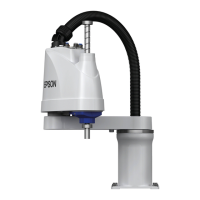T3-B T6-B Manipulator 5. Motion Range
84 T-B series Rev.1
Execute the following commands from the [Command Window].
calculated in Step (9) in X.
>MOTOR ON ' Turns ON the motor
>SPEED 5 ' Sets low speed
>PULSE 0,0,X,0 ' Moves to the lower limit-pulse position of Joint #3.
(In this example, all pulses except
those for Joint #3 are “0”.
Substitute these “0s” with the other pulse values
a position where there is no interference
even when lowering
Joint #3.)
5.3 Setting the Cartesian (Rectangular) Range in the XY
Coordinate System of the Manipulator (for Joints #1 and #2)
Use this method to set the upper and lower limits of the X and Y coordinates.
This setting is only enforced by software. Therefore, it does not change the physical range.
The maximum physical range is based on the position of the mechanical stops.
Set the XYLim setting on the [XYZ Limits]
panel shown by selecting [Tools]-
(You may also execute the XYLim command from the [Command Window].)
5.4 Standard Motion Range
The following “motion range” diagrams show the standard (maximum) specification. When
each Joint motor is under servo control, the center of Joint #3’s (shaft’s) lowest point moves
in the areas shown in the figure.
“Area limited by mechanical stop” is the area where the center of Joint #3’s lowest point
can be moved when each joint motor is not under servo control.
“Mechanical stop” sets the limited motion range so that the center of Joint #3 cannot move
beyond the area mechanically.
“Maximum space” is the area that contains the farthest reach of the arms. If the maximum
radius of the end effector is over 60 mm, add the “Area limited by mechanical stop” and
“radius of the end effector”. The total value is specified as the maximum area.
For the motion area figures, refer to “3.3 Mounting Dimensions”.

